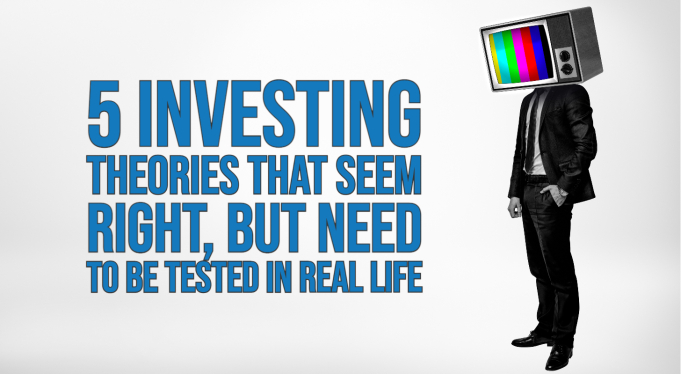Don’t Ever Buy Between 9:30 and 10 a.m. and Other Market Theories
I firmly and truly believe in the scientific process. Proving a thesis with a standardized, repeatable test just makes good sense. There are hundreds of studies every year that try to prove an investment thesis or economic theory, and my CFA charter gets me sent all sorts of reports and data trying to prove this, that and the other thing.
We can certainly see the attraction, since if you can find a market anomaly that provides consistent outsized returns, you can make a fortune before it is ultimately copied and returns are diluted by others doing the same thing. But for all the investment academics out there, we might suggest making your money first before publishing your thesis.
All these market/investment studies are interesting (at least for us market participants), but many simply have little practical value. Like many things, they just don’t work as well in real life as they do in the classroom. Still, I’ve always wanted to test some market theories. Alas, despite 30-plus years in the business, I’ve never had the time. If I did, here are some of the theories I would like to study academically to prove these points scientifically.
After a Big Stock Surge, Buy on The Second Day
The stock of a company that reports surprisingly good results will typically surge on the day of the announcement. Investors closely watching the stock love the news and add to their positions. But what about investors who are not watching so closely? They check in at the end of the day and see the stock is up 30 per cent. “Wow, that’s awesome,” they say, “it’s time to take some profit.” The next day, they, and anyone adjusting their position size, become a seller of the stock, and the price may check back five per cent or even more.
But the thesis here says that’s a buying opportunity. Business at the company has clearly changed for the better, and these sellers are just taking easy profits without regard to what’s changed at the company. Many investors see a stock move 30 per cent and think it’s overdone. But more often than not, it isn’t.
New Highs Are the Best Indicator for New Investment Ideas
I scan the new high list every single day without fail. Why? Well, simply, there are way too many stocks in North America to follow. Of course, I have my list of favourites. But in the small- and mid-cap sectors, there are still hundreds of companies I have never even heard of. This is where the new highs come in. A stock that hits a new 52-week high — or, better yet, an all-time high — tells me someone, somewhere likes the company. My job now is to find out why.
Think about it: an investor who pays more for a stock than anyone else in the world ever has must really like it. That doesn’t automatically mean it is a good investment. It just means someone else thinks it is. But as a single source of new ideas, I have found it very useful over the decades.
Don’t Ever Buy Between 9:30 and 10 a.m.
Most companies issue press releases before the market opens. Whether it is good news or bad news, investors tend to read the release, get all excited, or extra nervous, and then buy and sell accordingly.
On good news, smaller investors tend to bid up the pre-opening price of a stock, falling all over themselves trying to get a piece of the action. This frequently causes very big stock movements in the first half-hour of trading. But once this initial flurry of activity dies down, reality and common sense kick in, and the stock settles down, often significantly. A stock with a big gain at 9:45 a.m. can even reverse into a loss if investors on further analysis decide the news wasn’t so good after all.
It has become a general mantra of mine to never trade in the first half-hour. I would like to prove this is a wise decision.
Companies With Less Analysts Do Much Better
In my heart, I know this is true, but many believe a company with lots of analysts will get lots of attention and, therefore, have a higher valuation. But my argument is that a company with fewer analysts can focus on the long term rather than catering to the quarterly earnings cycle analysts and investors demand.
A company without analyst coverage may not need any capital (let’s face it, analysts still prefer companies that will one day raise money and generate commissions). It is usually cheaper (initially) so longer-term returns can be greater. It doesn’t have to tie up key executives on a continual basis to meet with said analysts. It’s a company that needs to perform well to even get noticed, so it does.
Initial Dividends Result in Higher Returns After the Dividend is Declared
This is one of my favourite possible indicators. A first dividend from a company is a big statement. It tells investors the company has achieved enough success that it can now share that with shareholders. Companies loathe having to cut their dividends, so the thought process to put the first one in place is very thorough. The board of a company needs to answer multiple questions: Will we still be able to pay the dividend in a recession? Will we still be able to pay the dividend and make planned acquisitions? And will paying a dividend limit our growth? Once these questions are decided, a company’s first dividend can be declared.
Many pension funds and other institutions cannot even buy shares of a company that doesn’t pay a dividend, so an initial dividend gets a new investor audience right away. Investors love dividends, and a new dividend puts a company’s stock on income investors’ radar screens. Stocks paying a dividend are less volatile (this has been proven) and so they can get higher valuations. These themes all make sense, but I would like to see it proven mathematically over decades to be sure.
Take Care,







Comments
Login to post a comment.